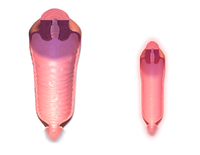
Photo from wikipedia
In Curaçao, hysterectomies are frequently performed. A common reason for this procedure is the high incidence of leiomyomatosis. However in some cases the cervix is conserved. Following supravaginal hysterectomy most… Click to show full abstract
In Curaçao, hysterectomies are frequently performed. A common reason for this procedure is the high incidence of leiomyomatosis. However in some cases the cervix is conserved. Following supravaginal hysterectomy most women discontinue cervical cancer screening because they think the cervix is not conserved. We aimed to get insight in the proportion of supravaginal hysterectomies and the level of awareness on the necessity to continue with cervical cancer screening in case of retained cervix. In 2014, data from all hysterectomies performed between 2003 and 2013 on Curaçao were collected. Information about: type of hysterectomy (supravaginal or not), age of the patient, reason for a hysterectomy and incidence of cervical cancer post-hysterectomy were obtained from the nationwide pathology database. In addition, 600 hysterectomised volunteers answered a questionnaire in which the awareness of their type of hysterectomy and continuation of screening for cervical cancer after surgery were investigated. In the at-risk population (≥ 15 years old), 6.0 per1000 women (95% CI 5.9–6.2) had a hysterectomy between 2003 and 2013 (n = 692,304). From the performed hysterectomies, 2.9% were supravaginal and no cases of cervical cancer post-hysterectomy were reported. The majority (55.3%) of women were unaware of their cervical status post-hysterectomy. About one-third (34.3%) of these women had their last Pap-smear pre-hysterectomy. Information campaigns are needed to raise awareness in women, to continue cervical-screening after supravaginal hysterectomy.
Journal Title: Preventive Medicine Reports
Year Published: 2017
Link to full text (if available)
Share on Social Media: Sign Up to like & get
recommendations!